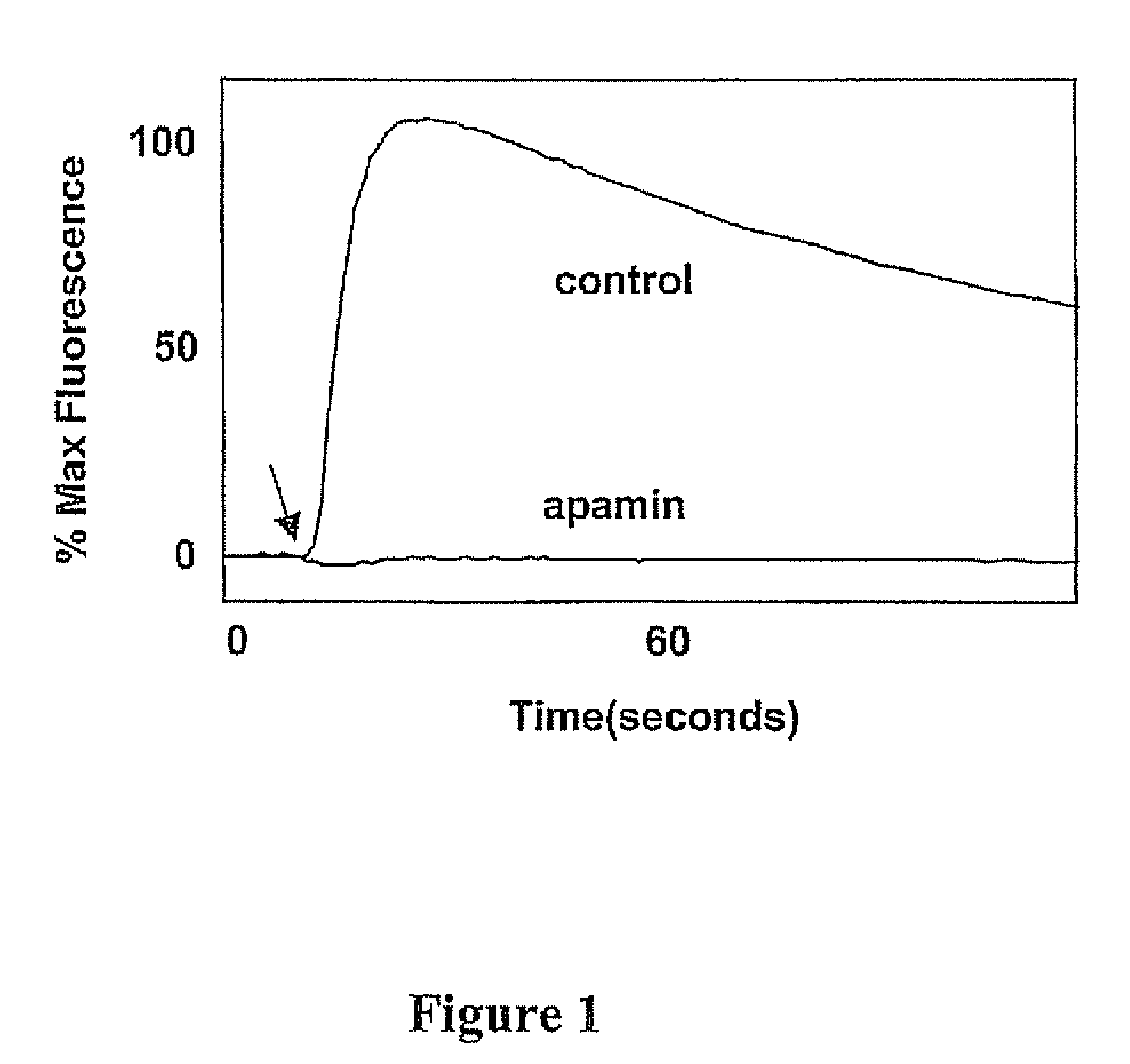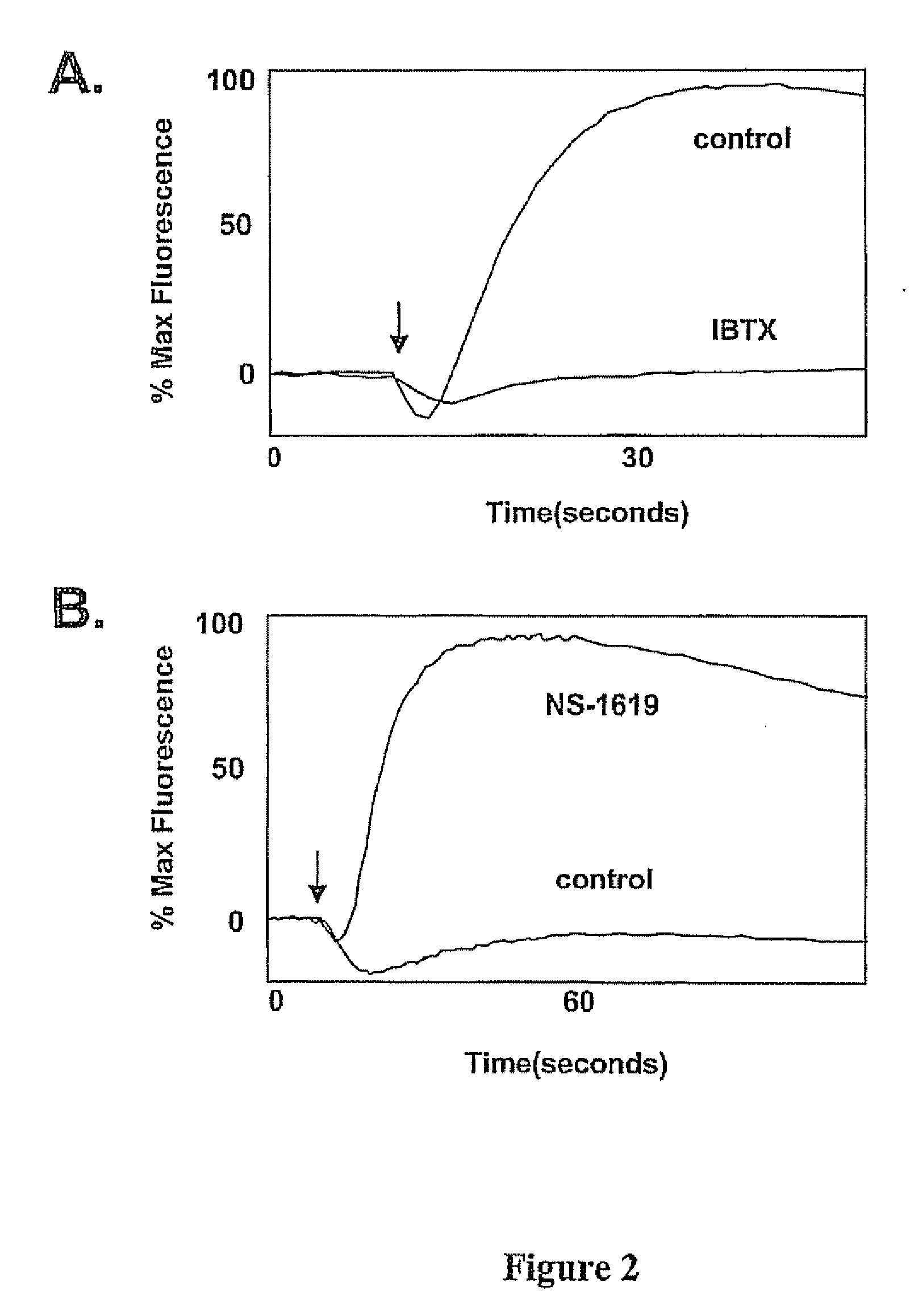Method for detecting modulators of ion channels using thallium (i) sensitive assays
a technology of modulators and ion channels, applied in the field of sensitive assays for detecting modulators of ion channels using thallium (i) and other directions, can solve the problems of limited assay number per day, radioactive isotopes requiring many safety precautions, and methods limited to vesicles, so as to achieve more robust and consistent results.
- Summary
- Abstract
- Description
- Claims
- Application Information
AI Technical Summary
Benefits of technology
Problems solved by technology
Method used
Image
Examples
example i
[0113] Example I describes expression of ion channels of interest in mammalian cells.
TABLE ICloneCell Line / ID / ConstructRestriction SitesVectorAntibiotic Conc.hSlo / BK5′HindIII / 3′BamHIpCDNA3HEK293 / G418 800μg / mlmKCNQ25′Blunt-ended / pCDNA3HEK293 / G418 8003′NotIμg / mlhSK25′EcoRi / 3′EcoRIpCDNA3HEK293 / G418 800μg / mlhVR15′ and 3′pIRESneoCHO / G418 500Blunt-ended into EcoRVμg / mlsite
[0114] Table I displays the DNA constructs used in the thallium sensitive assays in the examples. Restriction sites for each of the cloned illustrate how the ion channel cDNAs of interest were subcloned into the DNA vector (pCDNA3 (Invitrogen, Carlsbad, Calif.) and pIRESneo (Clonetech, Palo Alto, Calif.)) required for mammalian cell expression. The cell types (HEK; human embryonic kidney cells) and concentration of antibiotic used in the selection and preparation of stable cell lines are indicated. Standard molecular biology methodologies were utilized in the cloning of the ion channel genes listed in Table I. Detailed...
example ii
[0116] Example II demonstrates the ability of the thallium influx assay to measure the effect of a peptide inhibitor, Apamin (Sigma Chemical Co., St. Louis, Mo.; from bee venom), on small conductance calcium-activated K+ channels (SK2), (Kohler M, et al., Science. 1996, 273:1709-14), using changes in BTC fluorescence, as a measure of thallium influx.
[0117] A HEK-293 cell line (obtained from ATCC, Manassas, Va.) stably expressing the small conductance calcium-activated K+ channel (SK2) was seeded at .about.80% confluence in a 384 well microtiter plate, coated with poly-D-lysine plates, containing 20 μl / well low Cl− cell growth medium. The cells were allowed to incubate overnight at 37 C in a 5% CO2 incubator.
[0118] The cell-containing plates were removed from the incubator and loaded for approximately 15 min with 2 μM BTC-AM (Molecular Probes, Eugene, Oreg.) dissolved in 20 μL / well Cl−-free assay buffer containing amaranth and tartrazine (the final concentration in the assay is 2 m...
example iii
[0125] Example III demonstrates the use of the thallium influx assay of the invention to detect compounds that block or open Ca2+ sensitive, voltage-dependent Maxi-K channels using changes in BTC fluorescence as a measure of thallium influx.
[0126] All experimental conditions for this example were the same as Example II, with the following exceptions: [0127] 1. HEK-293 cells were stably transfected with Maxi-K channels. Cells expressing the large conductance calcium-activated K+ channel, Maxi-K (Dworetzky S I, Trojnacki J T, Gribkoff V K. Brain Res Mol Brain Res. 1994, 1:189-93) (a.k.a. BK, slo) were used; and [0128] 2. The channel opener used was NS-1619 (Sigma-Aldrich, St Louis, Mo.) at a final concentration of 15 μM. The channel blocker used was Iberiotoxin (Sigma-Aldrich, St. Louis, Mo.) at a final concentration of 100 nM.
[0129] To detect channel blockers, the assay was started by adding 11 μl of stimulus buffer containing: 15 μM ionomycin, 12.5 Tl2SO4 and 50 mM K2SO4 dissolved...
PUM
 Login to View More
Login to View More Abstract
Description
Claims
Application Information
 Login to View More
Login to View More - R&D
- Intellectual Property
- Life Sciences
- Materials
- Tech Scout
- Unparalleled Data Quality
- Higher Quality Content
- 60% Fewer Hallucinations
Browse by: Latest US Patents, China's latest patents, Technical Efficacy Thesaurus, Application Domain, Technology Topic, Popular Technical Reports.
© 2025 PatSnap. All rights reserved.Legal|Privacy policy|Modern Slavery Act Transparency Statement|Sitemap|About US| Contact US: help@patsnap.com



